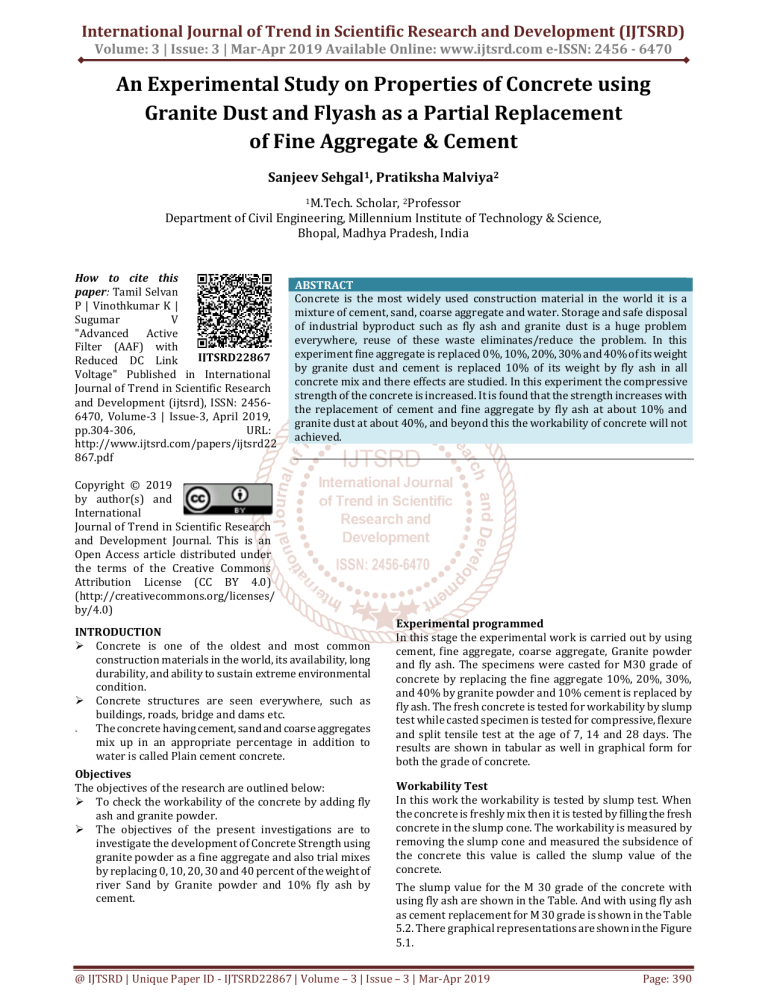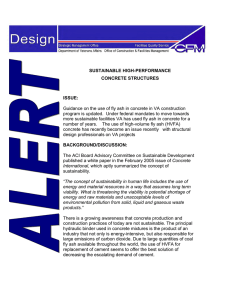
International Journal of Trend in Scientific Research and Development (IJTSRD)
Volume: 3 | Issue: 3 | Mar-Apr 2019 Available Online: www.ijtsrd.com e-ISSN: 2456 - 6470
An Experimental Study on Properties of Concrete using
Granite Dust and Flyash as a Partial Replacement
of Fine Aggregate & Cement
Sanjeev Sehgal 1, Pratiksha Malviya2
1M.Tech.
Scholar, 2Professor
Department of Civil Engineering, Millennium Institute of Technology & Science,
Bhopal, Madhya Pradesh, India
How to cite this
paper: Tamil Selvan
P | Vinothkumar K |
Sugumar
V
"Advanced
Active
Filter (AAF) with
IJTSRD22867
Reduced DC Link
Voltage" Published in International
Journal of Trend in Scientific Research
and Development (ijtsrd), ISSN: 24566470, Volume-3 | Issue-3, April 2019,
pp.304-306,
URL:
http://www.ijtsrd.com/papers/ijtsrd22
867.pdf
ABSTRACT
Concrete is the most widely used construction material in the world it is a
mixture of cement, sand, coarse aggregate and water. Storage and safe disposal
of industrial byproduct such as fly ash and granite dust is a huge problem
everywhere, reuse of these waste eliminates/reduce the problem. In this
experiment fine aggregate is replaced 0%, 10%, 20%, 30% and 40% of its weight
by granite dust and cement is replaced 10% of its weight by fly ash in all
concrete mix and there effects are studied. In this experiment the compressive
strength of the concrete is increased. It is found that the strength increases with
the replacement of cement and fine aggregate by fly ash at about 10% and
granite dust at about 40%, and beyond this the workability of concrete will not
achieved.
Copyright © 2019
by author(s) and
International
Journal of Trend in Scientific Research
and Development Journal. This is an
Open Access article distributed under
the terms of the Creative Commons
Attribution License (CC BY 4.0)
(http://creativecommons.org/licenses/
by/4.0)
INTRODUCTION
Concrete is one of the oldest and most common
construction materials in the world, its availability, long
durability, and ability to sustain extreme environmental
condition.
Concrete structures are seen everywhere, such as
buildings, roads, bridge and dams etc.
The concrete having cement, sand and coarse aggregates
mix up in an appropriate percentage in addition to
water is called Plain cement concrete.
Objectives
The objectives of the research are outlined below:
To check the workability of the concrete by adding fly
ash and granite powder.
The objectives of the present investigations are to
investigate the development of Concrete Strength using
granite powder as a fine aggregate and also trial mixes
by replacing 0, 10, 20, 30 and 40 percent of the weight of
river Sand by Granite powder and 10% fly ash by
cement.
Experimental programmed
In this stage the experimental work is carried out by using
cement, fine aggregate, coarse aggregate, Granite powder
and fly ash. The specimens were casted for M30 grade of
concrete by replacing the fine aggregate 10%, 20%, 30%,
and 40% by granite powder and 10% cement is replaced by
fly ash. The fresh concrete is tested for workability by slump
test while casted specimen is tested for compressive, flexure
and split tensile test at the age of 7, 14 and 28 days. The
results are shown in tabular as well in graphical form for
both the grade of concrete.
Workability Test
In this work the workability is tested by slump test. When
the concrete is freshly mix then it is tested by filling the fresh
concrete in the slump cone. The workability is measured by
removing the slump cone and measured the subsidence of
the concrete this value is called the slump value of the
concrete.
The slump value for the M 30 grade of the concrete with
using fly ash are shown in the Table. And with using fly ash
as cement replacement for M 30 grade is shown in the Table
5.2. There graphical representations are shown in the Figure
5.1.
@ IJTSRD | Unique Paper ID - IJTSRD22867 | Volume – 3 | Issue – 3 | Mar-Apr 2019
Page: 390
International Journal of Trend in Scientific Research and Development (IJTSRD) @ www.ijtsrd.com eISSN: 2456-6470
Designation
A'1 – 10
A'1 – 20
A'1 – 30
A'1 – 40
Table 1 Slump Value of the Different mix M-30 Concrete (with Fly ash)
Ingredients
Coarse Aggregate Fine Aggregate Granite Powder Cement Fly ash Slump Value in (mm)
%
%
%
%
%
100
90
10
90
10
75
100
80
20
90
10
72
100
70
30
90
10
63
100
60
40
90
10
56
Figure 5.1 Slumps of M-30 with 10% Flyash
Discussion: By analyzing the slump value, it is understand that the slump value is always decreases by increasing the
percentage of the Granite powder and replacing the cement by fly ash. The concrete with fly ash (10%) has the slump value
lower than that of concrete does not contain any fly ash.
COMPRESSIVE STRENGTH TEST
The result of the compressive strength with partial replacement of Granite powder and without using fly ash for 7, 14 and 28
days are shown for M-30 concrete and their graphical representation in the Figure 5.4 for M-30 Concrete. And by replacing
10% cement with fly ash along with Granite powder is shown in the Table 5.9 for M-30 concrete and their graphical
representation is shown in the Figure 5.5 and Figure 5.6 respectively.
Table 2 Compressive Strength of Different Mix of M-30 Concrete (with Flyash 10% & Cement 90%)
Granite Dust Compressive Strength in N/mm2 with 10% fly ash Sand Cement
Fly ash %
%
7 Days
14 Days
28 Days
%
%
0
20.02
26.62
32.52
100
100
0
10
24.74
27.42
34.36
90
90
10
20
25.96
28.9
35.8
80
90
10
30
26.32
29.21
35.26
70
90
10
40
28.8
30.6
36.96
60
90
10
Discussion: From the above table is seen that the compressive strength with 10% fly ash and 90% cement in M 30 grade of
concrete at 7, 14 and 28 days increases when the percentage of the Granite powder increase from 10% to40%
.
Figure 5.2 Compressive Strength of Different Mix of M-30 Concrete
(With Fly ash 10% & Cement 90%)
FLEXURE STRENGH TEST
The result of the flexure strength with partial replacement of Granite powderand without using fly ash for 7, 14 and 28 days are
shown in for M-30 concrete and their graphical representation in the for M-30 Concrete. And by replacing 10% cement with fly
ash along with Granite powder is shown in the Table.
@ IJTSRD | Unique Paper ID - IJTSRD22867 | Volume – 3 | Issue – 3 | Mar-Apr 2019
Page: 391
International Journal of Trend in Scientific Research and Development (IJTSRD) @ www.ijtsrd.com eISSN: 2456-6470
Table 3 Flexure Strength of Different Mix of M-30 Concrete (with Fly ash 10% & Cement 90%)
Granite Dust Flexural Strength in N/mm2 Sand Cement
Fly ash %
%
7 Days 14 Days 28 Days
%
%
0
4.12
4.98
5.2
100
100
0
10
20
4.22
4.36
5.41
5.32
6.39
6.69
90
80
90
90
10
10
30
4.82
5.37
7.02
70
90
10
40
4.98
5.38
7.08
60
90
10
Discussion: From the above table is seen that the flexure strength in M 30 grade of concrete with 20% fly ash and 90% cement
at 7, 14 and 28days increases when the percentage of the Granite powder increase from 10% to 40%.
Figure 5.3 Flexure Strength of Different Mix of M-30 Concrete (with Fly ash 10% & Cement 90%)
5.6 SPLIT TENSILE STRENGH TEST
The result of the split tensile strength with partial replacement of Granite powder and without using fly ash for 7, 14 and 28
days are shown in the Table 5.15 for M-30 concrete and their graphical representation in the M-30 Concrete. And by replacing
10% cement with fly ash along with Granite powder is shown in the Table for M-30 concrete and their graphical representation
is shown in the Figure.
Table 4 Split Tensile Strength of Different Mix of M-30 Concrete (with Fly ash 10% & Cement 90%)
Granite Dust Split Tensile Strength in N/mm2 Sand Cement
Fly ash %
%
7 Days
14 Days
28 Days
%
%
0
2.26
2.85
3.09
100
100
0
10
20
3.12
3.15
3.75
3.58
4.17
4.25
90
80
90
90
10
10
30
3.18
3.74
4.36
70
90
10
40
3.22
3.96
4.49
60
90
10
Discussion: From the above table is seen that the split tensile strength with 20% fly ash and 80% cement in M 30 grade of
concrete at 7, 14 and 28 days increases when the percentage of the Granite powder increase from 10% to 40%.
Figure 5.4 Split Tensile Strength of Different Mix of M-30 Concrete
(With Fly ash 10% & Cement 90%)
@ IJTSRD | Unique Paper ID - IJTSRD22867 | Volume – 3 | Issue – 3 | Mar-Apr 2019
Page: 392
International Journal of Trend in Scientific Research and Development (IJTSRD) @ www.ijtsrd.com eISSN: 2456-6470
Conclusion
From the above experiments, the study focuses the relative
performance of concrete by using the Granite powder as
partial replacement of the normal sand and fly ash as partial
replacement of cement. From the laboratory study, it can be
concluded that the Granite powder is well appropriate for
normal sand up to certain limits. And it has better
performance as compared to the sand. It is also concluded
that the fly ash can be used as cement replacement to certain
limits.
REFERENCES
[1] Abadi, M. H. S. , Delbari, A. , Fakoor, Z. & Baedi, J. , 2015.
Effects of Annealing Temperature on Infrared Spectra of
SiO2 Extracted From Rice Husk. J. Ceram. Sci. Tech. ,
06(01), pp. 41-46.
[2] Adam, F. , Saraswathy, B. & Wong, P. L. , 2006. Rice Husk
Ash Silica as a Support Material for Ruthenium Based
Heterogenous Catalyst. Journal of Physical Science, Vol .
17(2), pp. 1–13.
[3] Ali, F. & Al-Shawabkeh. , 2015. Evaluation of the Potential
Use of Waste Tires as Supplementary Fuel in Jordan
Cement Industry. Council for Innovative Research.
[4] Ali, M. B. , Saidur, R. & Hossain, M. S. , 2011. A Review on
Emission Analysis in Cement Industries. Renewable and
Sustainable Energy Reviews.
[5] Anderson, J. E. , Wulfhorst, G. & Lang, W. , 2015. Energy
Analysis of the built Environment—A Review and
Outlook. Renewable and Sustainable Energy Reviews.
[6] Antiohos S. K. , Papa dakis V. G. & Tsimas, S. , 2014. Rice
husk ash (RHA) effectiveness in cement and concrete as
a function of reactive silica and fineness. Cement and
Concrete Research.
@ IJTSRD | Unique Paper ID - IJTSRD22867 | Volume – 3 | Issue – 3 | Mar-Apr 2019
Page: 393



